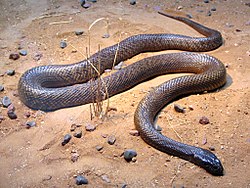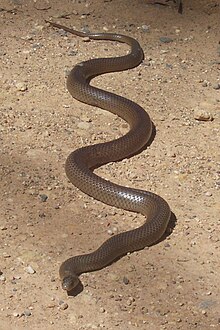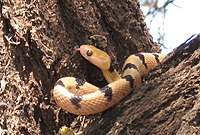
The inland taipan (Oxyuranus microlepidotus), the small-scaled snake, or the fierce snake,is an extremely venomous snake of the taipan , and is endemic to semi-arid regions of central east Australia.
The inland taipan is considered the most venomous snake in the world; based on the median lethal dose value in mice, Its venom, drop for drop, is by far the most toxic of any snake – much more so than even sea snakes and it has the most toxic venom of any reptile when tested on human heart cell culture. Unlike most snakes, the inland taipan is a specialist mammal hunter so its venom is specially adapted to kill warm-blooded species. It is estimated that one bite possesses enough lethality to kill at least 100 full grown men,and, depending on the nature of the bite, it has the potential to kill someone in as little as 30 to 45 minutes if left untreated. It is an extremely fast and agile snake which can strike instantly with extreme accuracy,often striking multiple times in the same attack,and it envenoms in almost every case.

The eastern brown snake is considered to be the second most venomous terrestrial snake. The venom has a SC LD50 range of 36.5 μg/kg and consists mostly of neurotoxins (pre- & post-synaptic neurotoxins) and blood coagulants. These snakes kept at venom supply laboratories yield an average of 2—10 mg of venom per milking. Engelmann and Obst (1981) give a venom yield of 2 mg (dry weight). As with most venomous snakes, the volume of venom produced is largely dependent on the size of the snake. Worrell (1963) reported a milking of 41.4 mg from a relatively large 2.1 metres (6.9 ft) specimen. This record is atypical, as the eastern brown snake yields a low volume of venom which is reported as not more than 10 mg, averaging only 2 mg (dry weight).
Clinically, the venom of the eastern brown snake is known to cause diarrhea, dizziness, collapse or convulsions, renal failure, paralysis and cardiac arrest. Without medical treatment, bites can be fatal. As this species tends to initiate their defence with non-fatal bites, the untreated mortality rate in most snakebite cases reported is 10–20%, which is not very high.

Bungarus candidus, commonly known as the Malayan krait or blue krait, is a species of krait, a venomous elapid snake.
In mice, the IV LD50 for this species is 0.1 mg/kg. Blue Krait's venom is lethal 50% even after administration of antivenom; without antivenom it is 70% lethal for humans.

The black mamba (Dendroaspis polylepis), also called the black-mouthed mamba, is a highly venomous snake of the genus Dendroaspis (Mambas), and is endemic to sub-Saharan Africa.
The venom of the black mamba is highly toxic. Based on the median lethal dose (LD50) values in mice, the black mamba LD50 is 0.28/0.32 mg/kg subcutaneous. Although there are other venomous snakes that exhibit higher LD50 toxicity scores, its venom is one of the most rapid-acting. In cases of severe envenomation, it is capable of killing an adult human in as little as 20 minutes.

Telescopus semiannulatus, commonly known as the tiger snake is a species of colubrid snake.
Tiger snake venoms possess potent neurotoxins, coagulants, haemolysins and myotoxins. Symptoms of a bite include localized pain in the foot and neck region, tingling, numbness, and sweating, followed by a fairly rapid onset of breathing difficulties and paralysis. In a study, the untreated mortality rate from its bites is reported to be between 40 and 60%.
PAGE - 1 2

No comments:
Post a Comment